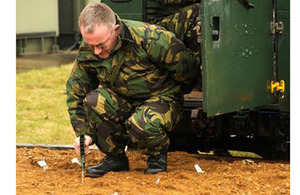RAF's 31 Squadron prepares for Afghanistan
The aircrew of 31 Squadron who will be flying their Tornados over Afghanistan to support ground troops this summer have been preparing for their deployment with a series of training exercises.

A member of 31 Squadron engaged in counter-improvised explosive device training [Picture: Senior Aircraftwoman Ellie Insley, Crown Copyright/MOD 2011]
Aside from performing in their primary role as aircrew, the pilots and navigators from the squadron must also learn and develop their skills from a ground perspective. And, as a first step towards achieving this, they recently conducted the first part of their work-up training at RAF Marham.
This Individual Readiness Training (IRT) took the form of a number of structured lessons, briefs, practical tests and theory discussions over a two-day period.
Members of No 3 RAF Force Protection Wing began the event by briefing 31 Squadron on the theory of mines and mine extraction. The Force Protection Wing personnel, who are experts in land skills such as weapons and first aid, are responsible for instructing Royal Air Force personnel in these capabilities, as well as protecting an airfield by establishing a ground presence around its perimeter, both at home and on operations.
Mines and improvised explosive devices (IEDs) are currently the main threats to coalition troops on the ground in Afghanistan. One of the Tornado’s responsibilities is to conduct counter-IED-related tasks using the Reconnaissance Airborne Pod for Tornado (RAPTOR) and the Litening III laser targeting and reconnaissance pod to identify potential areas of interest.
The practical session after the briefing consisted of a comprehensive mine clearing and casualty evacuation exercise, giving the aircrew an understanding of the magnitude of the threats that are faced on a daily basis by forces on the ground whilst Tornado aircraft provide overwatch from the skies above.
The next session focused on weapons training, culminating in a weapon-handling test. For a number of aircrew this was the first time that they had handled a pistol, having only just recently joined the squadron after completing their Tornado flying training.

Members of 31 Squadron practise firing pistols [Picture: Senior Aircraftwoman Ellie Insley, Crown Copyright/MOD 2011]
The aircrew train with this weapon because all personnel, regardless of branch, are required to be able to handle a weapon when deployed on operations. The weapon-handling test is necessary to satisfy the instructors of the Force Protection Wing that the aircrews can safely handle the weapon.
After all the aircrew had mastered the pistol and passed the test, the group then moved on to the first aid training. Following a first aid theory lecture the practical session commenced with the group practising applying a tourniquet and other techniques for dealing with a variety of injuries.
The focus was on dealing with major trauma, a skill vital to all personnel deployed on operations.
The training finished with an identification session of the types of wildlife that might be encountered on operations, such as scorpions and sand spiders, and instruction in the methods for dealing with these creatures.
One of the new members of 31 Squadron undertaking this training for the first time was Weapons Systems Officer Flight Lieutenant Rutherford who said:
IRT has been a valuable experience for all of us. It is important to begin the work-up with the correct attitude and focus, that being our support to ground forces. It has allowed us to better understand the threat our troops face daily as we prepare for Op HERRICK and how we can utilise our aircraft to help.
31 Squadron is already a close team of people and training together as a squadron instils an operational focus, and has already begun to build the extra rapport between us that will increase our ability to perform in a timely manner on operations.